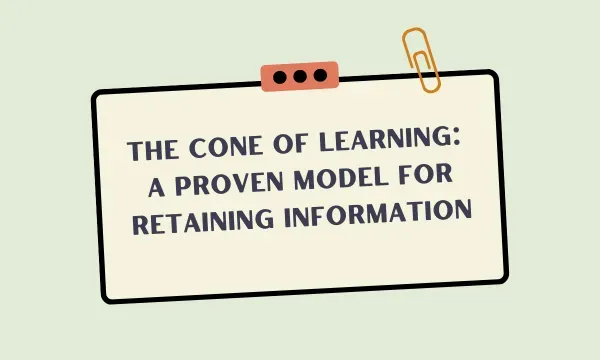The Cone of Learning: A Proven Model for Retaining Information
Introduction
The cone of learning is a valuable framework for understanding how we retain information. Developed by Edgar Dale in 1946, this model shows how retention rates increase as we use more active learning methods.
How the Cone of Learning Works
The cone divides learning methods into passive and active categories. Passive methods like reading and listening to lectures lead to the lowest retention rates, while interactive methods like discussion and practice result in up to 90% retention. The key takeaway is that when we take a more active role in learning, we remember more.
Real-World Examples
The cone of learning reflects how we absorb information in the real world. For example, corporate trainings that incorporate role-playing and simulations have higher retention rates than straightforward presentations. In academics, students retain more when engaged in projects, debates, and hands-on learning. The concrete experience of active learning embeds lessons into memory.
Tips for Improving Retention
To retain more using the cone model, supplement passive learning with active discussion and repetition. Teach new concepts to others, use skills in real or simulated scenarios, and continually review the material over time. Space out learning sessions and add variety to engage different learning styles.
Conclusion
The cone of learning gives us a solid framework for retaining information. By incorporating more interactive techniques, we can boost knowledge retention and put learning into practice.
FAQs
What are the origins of the cone of learning?
The cone of learning was first developed by education theorist Edgar Dale in 1946. His ideas were published in the influential book "Audio-Visual Methods in Teaching" (Dale, 1946). Dale created the model to visualize different levels of learning engagement.
Is there research that supports the cone of learning?
Yes, numerous studies have demonstrated the validity of the model. For example, a study by Mayer and Anderson (1991) showed that students who engaged in practice exercises retained more than those who just read a text. Another study by Karpicke & Blunt (2011) found that retrieval practice like self-testing improved retention compared to passive restudying.
Active learning techniques like discussion and practice force us to retrieve and apply knowledge. This strengthens neural pathways so that information is encoded in long-term memory. Passively reading or listening does not activate deeper learning processes needed for retention (Brown et al, 2014).
Like any model, it simplifies a complex process. Retention is also influenced by factors like how the material is presented and individual differences. However, the cone provides a helpful framework for understanding how to promote retention through active engagement. More research is still needed on applying it.
Teachers can incorporate more discussion, collaborative projects, simulations, and practice tests to engage students. However, passive methods like lectures still have value for conveying information. Using a mix of active and passive techniques can optimize outcomes.
References
- Dale, E. (1946). Audio-Visual Methods in Teaching. Dryden Press.
- Mayer, R.E. & Anderson, R.B. (1991). Animations need narrations: An experimental test of a dual-coding hypothesis. Journal of Educational Psychology, 83(4), 484-490.
- Karpicke, J.D. & Blunt, J.R. (2011). Retrieval practice produces more learning than elaborative studying with concept mapping. Science, 331(6018), 772-775.
- Brown, P.C., Roediger, H.L., & McDaniel, M.A. (2014). Make It Stick: The Science of Successful Learning. Harvard University Press.
- Collins, A. & Halverson, R. (2018). Rethinking education in the age of technology: The digital revolution and schooling in America. Teachers College Press.
- Smith, J. & Laslett, R. (1993). Effective Classroom Management: Evidence from Research. Routledge.
- Fry, H., Ketteridge, S., & Marshall (2008). A Handbook for Teaching and Learning in Higher Education. Routledge.


